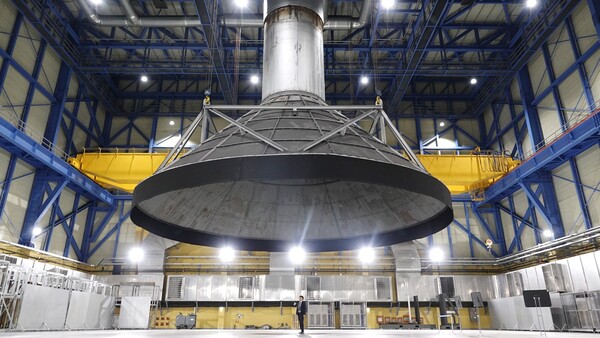Opening of the World's Largest ESS Fire Testing Center
Article by IT Chosun, Reporter Jo Sung-woo.
As major countries worldwide ramp up their efforts to expand renewable energy for carbon neutrality and improved energy efficiency, the significance of ESS (Energy Storage System) is gaining increasing attention. ESS plays a pivotal role in storing and delivering the electricity generated.
In anticipation of the rapid growth in the ESS market, Korea Testing Certification institute (KTC) and Korea Conformity Laboratories (KCL) have established the world's largest ESS fire testing center in Samcheok, Gangwon Province, to facilitate the secure deployment of ESS.

△ ESS Fire Safety Testing Center's 30MW Heat Release Measurement Device
Unique Infrastructure for ESS Fire Safety Verification in Korea
The testing center, as per KTC, boasts extensive facilities, including large dust collectors, a 30MW heat release measurement device, a mobile sprinkler system, and electrical hazard assessment equipment. Notably, the hood of the 30MW heat release measurement device boasts a diameter of 15 meters.
Youngtak Kim, a principal researcher at KTC's Battery Center, expounded, "The testing center is one of the government's core policy support initiatives, established with the objective of creating a secure environment for ESS utilization." He added, "A total investment of 69.8 billion won since 2020 has been dedicated to its construction, aimed at precisely identifying the causes of ESS fire incidents and ensuring the safety of critical components."
Moreover, he highlighted, "We are the sole entity in Korea to establish a comprehensive testing and certification infrastructure for fire safety, covering the entire developmental cycle of secondary batteries and ESS products." He continued, "Until now, ESS testing and evaluation infrastructure were scattered across the country, rendering it impossible to conduct electrical hazard tests and fire safety assessments at a single location. However, with the establishment of the testing center, Korean enterprises can now conduct fire incident investigations and simulations in a unified setting."
Kim delineated that the testing center is divided into two primary stages for systematic ESS system fire prediction testing. The first stage focuses on fire prevention by analyzing the causes of potential fires in ESS products through electrical hazard tests.
The second stage, he elucidated, is dedicated to fire mitigation. It involves observing flame propagation during a fire and conducting practical trials of effective firefighting methods.
Kim underscored, "The principal causes of ESS fire incidents can be broadly categorized into external factors such as installation and environmental conditions, along with electrical hazard factors like short circuits, insulation degradation, and overcharging."

△ Explanation by Youngtak Kim, Principal Researcher at KTC's Battery Center, on the 30MW Heat Release Measurement Device
He further expounded, "ESS comprises a power management system (PMS), power control unit (PCS), battery management system (BMS), and batteries, underscoring the critical nature of electrical hazard verification in the demonstration phase." He added, "To facilitate the safe deployment of ESS, empirical testing is imperative to analyze diverse factors that might trigger fires. Developing operational protocols for assessments based on electrical hazard factors and establishing a systematic framework for empirical testing in line with these factors can proactively analyze ESS fire causes and readiness."
In terms of electrical hazard testing and evaluation facilities, Kim detailed that these encompass a 2MW ESS power supply device for simulating system malfunctions, a short circuit test facility for analyzing short circuits and insulation degradation, a surge test device for assessing abnormal events caused by overvoltages such as lightning and switching, and a High voltage Charge/Discharge machine utilized for evaluating battery system safety for KC certification.
Kim also underscored the presence of equipment capable of measuring the world's largest heat release of 30MW at the 30MW-scale fire test site. He indicated, "We can instantaneously measure up to 40MW. A 30MW fire scale is comparable to the heat release when an entire bus or subway experiences a fire." Additionally, he emphasized, "The fire test site allows for real tests on large-scale fires, including investigations into fire causes, evaluation of fire scale, and measurement of harmful gases, instead of merely simulating large-scale fires."
Regarding smoke collection facilities, Kim explicated that large smoke collectors deliver the necessary flow rates for 30MW heat release tests and eliminate smoke and harmful gases generated during combustion. He stated, "To prevent fires stemming from high temperatures, the smoke collector features a primary wet cleaning and a secondary dry filter." He concluded, "By timely replacing wet cleaning water and dry filters, we aim to optimize the efficiency of the combustion exhaust gas purification system and proactively prevent environmental harm through routine atmospheric environment measurements."
Development of Korean Fire Safety Testing and Certification, Heading Toward International Certification

△ 30MW-Scale Large Smoke Collector
Kim stressed that the testing center, commencing full operations this month, will play a pivotal role in advancing Korean fire safety testing, certification, and ESS certification within the industry. He elucidated that the center will supplement and develop standards for ESS installation and operation in Korea, aligned with global certification standards, thus ensuring the safety of ESS products manufactured in Korea and fostering the activation of the industrial ecosystem.
Kim affirmed, "The testing center has secured KOLAS (Korea Laboratory Accreditation Scheme) recognition for secondary battery testing and has been designated as a testing facility by TUV Rheinland, a global testing and certification organization, alongside international certification institutions." He continued, "ESS exporting firms can avail product testing and evaluation through the testing center, in addition to obtaining international certifications, which will lead to savings in time and transportation costs for certification acquisition."
In conclusion, Kim emphasized, "The ESS fire safety testing center boasts world-class infrastructure that enables empirical testing of large-scale ESS fires, a capability hitherto unavailable to domestic enterprises. We will actively support Korean companies and champion the secure deployment of ESS at the highest global level. Furthermore, we will strive to enhance our firms' competitive edge in exports and contribute to national safety.“


